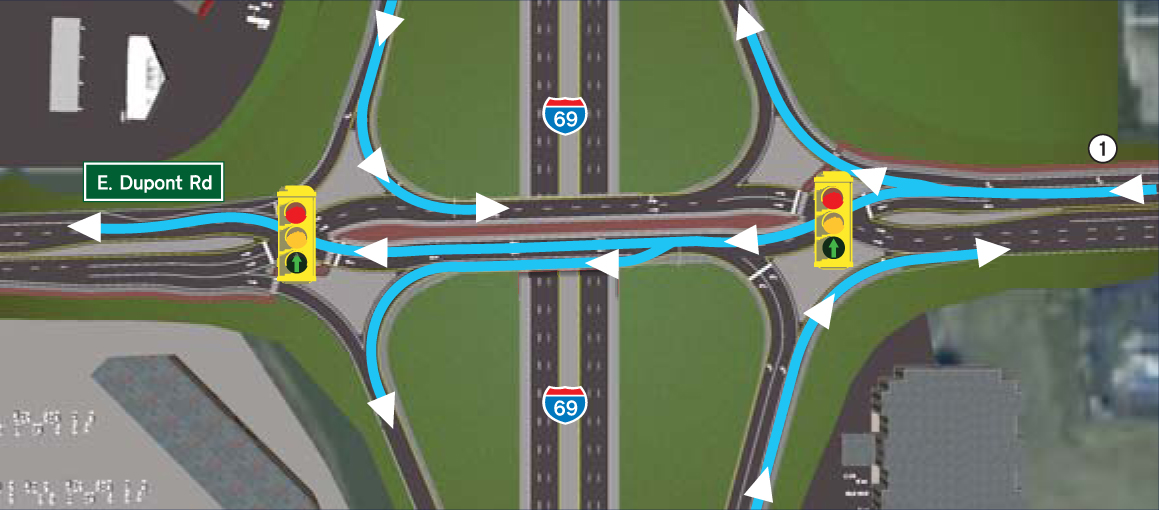A Diverging Diamond Interchange (DDI) is a type of interchange in which the two directions of traffic on a non-highway road cross to the opposite side on both sides of a bridge. It is unusual in that it requires traffic on the highway overpass to briefly drive on the opposite side of the road from what is customary.
 When entering the DDI, drivers cross over to the left side of the bridge, guided by signals, signs and pavement markings. DDIs are designed to be safer, more efficient and more cost effective than traditional diamond interchanges.
When entering the DDI, drivers cross over to the left side of the bridge, guided by signals, signs and pavement markings. DDIs are designed to be safer, more efficient and more cost effective than traditional diamond interchanges.
The DDI accommodates high volumes of left turns at signalized interchanges by eliminating the need for left-turn phase signals. On the non-highway crossing road, traffic crosses over from the right side to the left side of the road at the ramp terminals. Two-phase traffic signals are installed at the crossovers. Once on the left side of the road, vehicles can turn left onto highway ramps without stopping and without conflicting with through traffic. This is a significant improvement in safety, since no left turns must clear opposing traffic and all movements are controlled by traffic signals.
INDOT has constructed and opened two Diverging Diamond interchanges in Indiana. The first, at I-69 and State Road 1 (Dupont Road) in Allen County, opened in October 2014. The second, at I-65 and Worthsville Road in Johnson County, opened in November 2015.
DDI Advantages
Innovative designs such as the DDI promote safety, increase capacity, decrease congestion and minimize the cost of new infrastructure. DDI advantages include:
- Safety: DDIs reduce the number of potential conflict points by eliminating conflicts between vehicles turning left and opposing traffic. DDIs have two crossing conflicts; conventional diamond interchanges have four. Generally, reducing conflict points reduces crashes.
- Efficiency: Traffic congestion is reduced by eliminating the left-turn phase from the traffic signal cycle. This increases capacity and allows traffic to flow through the interchange more efficiently.
- Cost Savings: The cost to construct a DDI is typically less than a traditional diamond interchange. A DDI typically needs fewer lanes to accommodate the same number of vehicles. Many times, the bridge will not need to be widened for traffic. This reduces construction time and public inconvenience.
- Right-of-Way: Generally, right-of-way acquisition is not needed or is minimized due to the compact nature of the interchange.
Driver Guidance
The DDI design requires drivers to cross to the opposite side of the road for a limited distance, and then cross back to the traditional side. Several key design elements are utilized to help prevent driver error:
- Roadway geometry is used to control vehicle speed and direct the driver through the crossing intersections.
- Barrier and/or glare screens block the view of opposing traffic and give the driver the feel of traveling on a one-way street.
- Green arrows are used on the traffic signal heads instead of the traditional solid green light.
In a Federal Highway Administration DDI simulation study, not one of the more than 1,000 participants drove the wrong direction at the crossovers or incorrectly turned into oncoming traffic lanes.
How a Diverging Diamond Works
Diverging Diamond Intersection Examples
- I-65 at Worthsville Road near Greenwood
- I-70 at SR 39 near Monrovia
- I-69 at Campus Parkway in Noblesville
- I-69 at SR 1/Dupont Road in Fort Wayne
Related Links
Contact Information
Transportation Services Call Center
Indiana Department of Transportation
100 N. Senate Ave., IGCN 755
Indianapolis, IN 46204
855-463-6848
indot4u.com
